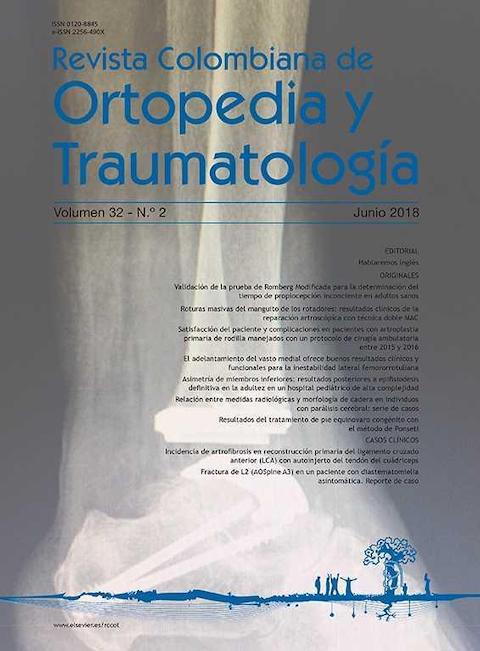Roturas masivas del manguito de los rotadores: resultados clínicos de la reparación artroscópica con técnica doble MAC
DOI:
https://doi.org/10.1016/j.rccot.2017.08.006Palabras clave:
artroscopia de hombro, reparación del manguito de los rotadores, técnica doble MAC, roturas masivasResumen
Introducción: Las roturas masivas del manguito de los rotadores representan una de las lesiones más complejas a las cuales se puede enfrentar el ortopedista especialista en hombro y son un gran reto cuando se desean lograr resultados clínicos satisfactorios. El objetivo del trabajo es describir los resultados clínicos de una nueva técnica quirúrgica para la reparación artroscópica de lesiones grandes y masivas del manguito de los rotadores (MR) utilizada en una clínica ortopédica especializada durante un período de 3 años.
Materiales y métodos: Se realizó un estudio descriptivo de una cohorte de pacientes con lesiones grandes y masivas del MR, diagnosticados mediante artrorresonancia directa y que cumplían criterios para reparación artroscópica, a los cuales se les realizó la reparación mediante una nueva técnica denominada doble MAC. Se analizaron como desenlaces la escala de Constant postoperatoria, la existencia de complicaciones y el grado de satisfacción de los pacientes con el procedimiento.
Resultados: Se evaluó a 21 pacientes (10 hombres y 11 mujeres) con una media de edad de 59,4 años (DE: 8,2) en el momento de la cirugía. Las roturas comprometieron el músculo supraespinoso en todos los casos y en el 42,8% el infraespinoso con un tamaño medio de rotura de 34,5 mm (DE: 11,2). El tiempo entre la cirugía y la evaluación fue, por término medio, de 9 meses. La escala de Constant postoperatoria fue, por término medio, de 77,4 (DE: 9,0). No se presentaron complicaciones en la cirugía o falla de los anclajes. Solo un paciente presentó capsulitis adhesiva temprana, que se trató con movilización articular, con la cual se logró normalizar todos los arcos de movilidad.
Discusión: La técnica doble MAC para la reparación artroscópica de las lesiones grandes y masivas del manguito de los rotadores es una técnica segura y efectiva, con buenos resultados funcionales evaluados a medio plazo y un porcentaje de satisfacción superior al 90%.
Nivel de evidencia clínica: Nivel IV.
Descargas
Referencias bibliográficas
Goutallier D, Postel JM, Gleyze P, Leguilloux P, Van Driessche S. Influence of cuff muscle fatty degeneration on anatomic and functional outcomes after simple suture of full-thickness tears. J Shoulder Elbow Surg. 2003;12:550-4. https://doi.org/10.1016/S1058-2746(03)00211-8
Bedi A, Dines J, Warren RF, Dines DM. Massive tears ofthe rotator cuff. J Bone Joint Surg Am. 2010;92:1894-908. https://doi.org/10.2106/JBJS.I.01531
DeOrio JK, Cofield RH. Results of a second attempt at surgical repair of a failed initial rotator-cuff repair. J Bone Joint Surg Am. 1984;66:563-7. https://doi.org/10.2106/00004623-198466040-00011
Gerber C, Fuchs B, Hodler J. The results of repair of massive tears of the rotator cuff. J Bone Joint Surg Am. 2000;82:505-15. https://doi.org/10.2106/00004623-200004000-00006
Davidson J, Burkhart SS. The geometric classification of rotator cuff tears: a system linking tear pattern to treatment and prognosis. Arthroscopy. 2010;26:417-24. https://doi.org/10.1016/j.arthro.2009.07.009
Jones CK, Savoie FH. Arthroscopic repair of large and massive rotator cuff tears. Arthroscopy. 2003;19:564-71. https://doi.org/10.1016/S0749-8063(03)00169-5
Holtby R, Razmjou H. Relationship between clinical and surgical findings and reparability of large and massive rotator cuff tears: a longitudinal study. BMC Musculoskelet Disord. 2014;15:180. https://doi.org/10.1186/1471-2474-15-180
Boileau P, Ahrens PM, Hatzidakis AM. Entrapment of the long head of the biceps tendon: the hourglass biceps-a cause of pain and locking of the shoulder. J Shoulder Elb Surg. 2004;13:249-57. https://doi.org/10.1016/j.jse.2004.01.001
Greenspoon JA, Petri M, Warth RJ, Millett PJ. Massive rotator cuff tears: pathomechanics, current treatment options, and clinical outcomes. J Shoulder Elbow Surg. 2015;24:1493-505. https://doi.org/10.1016/j.jse.2015.04.005
Denard PJ, Jiwani AZ, Lädermann A, Burkhart SS. Long-term outcome of arthroscopic massive rotator cuff repair: the importance of double row fixation. Arthroscopy. 2012;28:909-15. https://doi.org/10.1016/j.arthro.2011.12.007
Galatz LM, Ball CM, Teefey SA, Middleton WD, Yamaguchi K. The outcome and repair integrity of complete arthroscopically repaired large and massive rotator cuff tears. J Bone Joint Surg Am. 2004;86:219-24. https://doi.org/10.2106/00004623-200402000-00002
Mazzocca AD, Millett PJ, Guanche CA, Santangelo SA, Arciero RA. Arthroscopic single-row versus double-row suture anchor rotator cuff repair. Am J Sports Med. 2005;33:1861-8. https://doi.org/10.1177/0363546505279575
Millett PJ, Mazzocca A, Guanche CA. Mattress double anchor footprint repair: a novel, arthroscopic rotator cuff repair technique. Arthroscopy. 2004;20:875-9. https://doi.org/10.1016/S0749-8063(04)00808-4
Hein J, Reilly JM, Chae J, Maerz T, Anderson K. Retear rates after arthroscopic single-row, double-row, and suture bridge rotator cuff repair at a minimum of 1 year of imaging follow-up: A systematic review. Arthroscopy. 2015;31:2274-81. https://doi.org/10.1016/j.arthro.2015.06.004
Millett PJ, Warth RJ, Dornan GJ, Lee JT, Spiegl UJ. Clinical and structural outcomes after arthroscopic single-row versus double-row rotator cuff repair: a systematic review and meta-analysis of level I randomized clinical trials. J Shoulder Elbow Surg. 2014;23:586-97. https://doi.org/10.1016/j.jse.2013.10.006
Burkhart SS. Arthroscopic treatment of massive rotator cuff tears. Clin Orthop. 2001;390:107-18. https://doi.org/10.1097/00003086-200109000-00013
Jones CK, Savoie FH. Arthroscopic repair of large and massive rotator cuff tears. Arthroscopy. 2003;19:564-71. https://doi.org/10.1016/S0749-8063(03)00169-5
Denard PJ, Lädermann A, Jiwani AZ, Burkhart SS. Functional outcome after arthroscopic repair of massive rotator cuff tears in individuals with pseudoparalysis. Arthroscopy. 2012;28:1214-9. https://doi.org/10.1016/j.arthro.2012.02.026
Hanusch BC, Goodchild L, Finn P, Rangan A. Large and massive tears of the rotator cuff: functional outcome and integrity of the repair after a mini- open procedure. J Bone Joint Surg Br. 2009;91:201-5. https://doi.org/10.1302/0301-620X.91B2.21286
Boileau P, Ahrens PM, Hatzidakis AM. Entrapment of the long head of the biceps tendon: the hourglass biceps-a cause of pain and locking of the shoulder. J Shoulder Elb Surg. 2004;13:249-57. https://doi.org/10.1016/j.jse.2004.01.001
Sheibani-Rad S, Giveans MR, Arnoczky SP, Bedi A. Arthroscopic single- row versus double-row rotator cuff repair: a meta-analysis of the randomized clinical trials. Arthroscopy. 2013;29:343-8. https://doi.org/10.1016/j.arthro.2012.11.019
Constant CR, Murley AH. A clinical method of functional assessment of the shoulder. Clin Orthop. 1987:160-4. https://doi.org/10.1097/00003086-198701000-00023
Van der Zwaal P, Pool LD, Hacquebord ST, van Arkel ERA, van der List MPJ. Arthroscopic side-to-side repair of massive and contracted rotator cuff tears using a single uninterrupted suture: the shoestring bridge technique. Arthroscopy. 2012;28:754-60. https://doi.org/10.1016/j.arthro.2011.11.006
Carbonell I, Martínez AA, Aldea E, Ripalda J, Herrera A. Outcome and structural integrity of rotator cuff after arthroscopic treatment of large and massive tears with double row technique: a 2-year follow-up. Adv Orthop. 2013;2013:914148. https://doi.org/10.1155/2013/914148
Koh KH, Kang KC, Lim TK, Shon MS, Yoo JC. Prospective randomized clinical trial of single- versus double-row suture anchor repair in 2- to 4-cm rotator cuff tears: clinical and magnetic resonance imaging results. Arthroscopy. 2011;27:453-62. https://doi.org/10.1016/j.arthro.2010.11.059
Gerber C, Wirth SH, Farshad M. Treatment options for massive rotator cuff tears. J Shoulder Elb Surg. 2011;20:S20-9. https://doi.org/10.1016/j.jse.2010.11.028
Holtby R, Razmjou H. Relationship between clinical and surgical findings and reparability of large and massive rotator cuff tears: a longitudinal study. BMC Musculoskelet Disord. 2014;15:180. https://doi.org/10.1186/1471-2474-15-180
Burkhart SS, Danaceau SM, Pearce CE. Arthroscopic rotator cuff repair: Analysis of results by tear size and by repair technique-margin convergence versus direct tendon-to-bone repair. Arthroscopy. 2001;17:905-12. https://doi.org/10.1053/jars.2001.26821
Hegedus EJ, Goode AP, Cook CE, Michener L, Myer CA, Myer DM, et al. Which physical examination tests provide clinicians with the most value when examining the shoulder? Update of a systematic review with meta- analysis of individual tests. Br J Sports Med. 2012;46:964-78. https://doi.org/10.1136/bjsports-2012-091066
Oh JH, Kim SH, Shin SH, Chung SW, Kim JY, Kim SH, et al. Outcome of rotator cuff repair in large-to-massive tear with pseudoparalysis: A comparative study with propensity score matching. Am J Sports Med. 2011;39:1413-20. https://doi.org/10.1177/0363546511399865
Lehman C, Cuomo F, Kummer FJ, Zuckerman JD. The incidence of full thickness rotator cuff tears in a large cadaveric population. Bull Hosp Jt Dis N Y N. 1995;54:30-1.
Yamaguchi H, Suenaga N, Oizumi N, Hosokawa Y, Kanaya F. Will preoperative atrophy and fatty degeneration of the shoulder muscles improve after rotator cuff repair in patients with massive rotator cuff tears? Adv Orthop. 2012;2012:195876. https://doi.org/10.1155/2012/195876
Ellman H, Hanker G, Bayer M. Repair of the rotator cuff Endresult study of factors influencing reconstruction. J Bone Joint Surg Am. 1986;68:1136-44. https://doi.org/10.2106/00004623-198668080-00002
Walch G, Maréchal E, Maupas J, Liotard JP. [Surgical treatment of rotator cuff rupture Prognostic factors]. Rev Chir Orthopédique Réparatrice Appar Mot. 1992;78:379-88.
Goutallier D, Postel J-M, Gleyze P, Leguilloux P, Van Driessche S. Influence of cuff muscle fatty degeneration on anatomic and functional outcomes after simple suture of full-thickness tears. J Shoulder Elb Surg. 2003;12:550-4. https://doi.org/10.1016/S1058-2746(03)00211-8
Goutallier D, Postel JM, Lavau L, Bernageau J. [Impact of fatty degeneration of the supraspinatus and infraspinatus muscles on the prognosis of surgical repair of the rotator cuff]. Rev Chir Orthopédique Réparatrice Appar Mot. 1999;85:668-76.
Burkhart SS, Barth JRH, Richards DP, Zlatkin MB, Larsen M. Arthroscopic repair of massive rotator cuff tears with stage 3 and 4 fatty degeneration. Arthroscopy. 2007;23:347-54. https://doi.org/10.1016/j.arthro.2006.12.012
Gartsman GM. Massive irreparable tears of the rotator cuff Results of operative debridement and subacromial decompression. J Bone Joint Surg Am. 1997;79:715-21. https://doi.org/10.2106/00004623-199705000-00011
Lapner PL, Sabri E, Rakhra K, McRae S, Leiter J, Bell K, et al. A multicenter randomized controlled trial comparing singlerow with double-row fixation in arthroscopic rotator cuff repair. J Bone Joint Surg Am. 2012;94:1249-57. https://doi.org/10.2106/JBJS.K.00999









